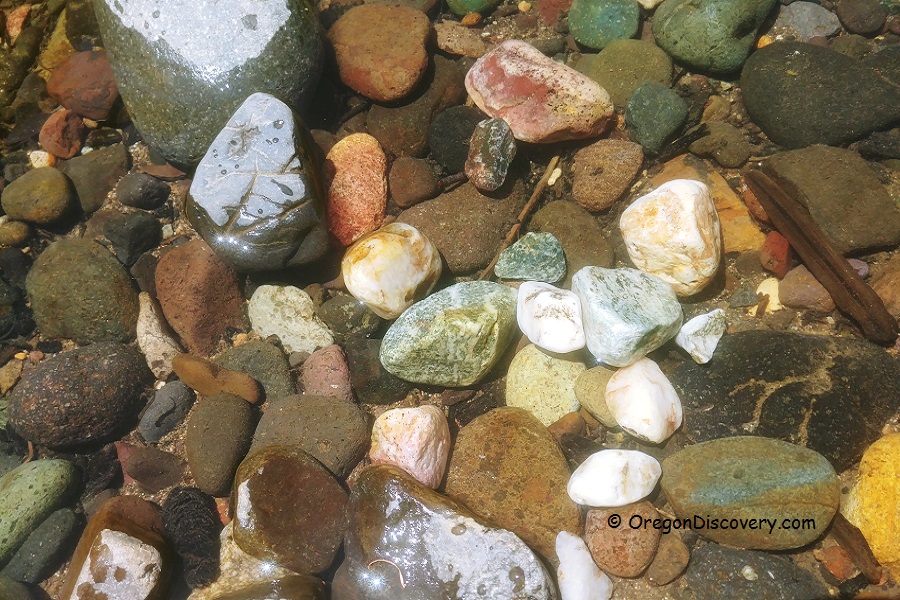
Name Jasper is derived from the old French language that means “spotted” or “mottled”.
Like agate, a jasper mineral is originated from chalcedony (a type of quartz) and features iron oxides, hydroxides, and other impurities, which create unique color combinations: yellow, brick-red, brown, mottled green, and, rarely, blue. Typically, jasper is spotted or striped, and multicolored. An adequate amount of mineral impurities make jasper opaque. According to the Mohs scale, a hardness of Jasper is 6.5-7.
Generally, a rough jasper mineral looks dull and need to be polished to reveal its unique color and shiny surface. While low on monetary value, jaspers can be used to create stunning jewelry and decorative pieces.
The most beautiful in the world "Morrisonite Jasper" with dark brown, tan and purple cores was found in 1947 in the Owyhee desert canyon, Southeastern Oregon.
Jasper Mineral Formation
Most jaspers formed millions of years ago when gases in volcano lava had been trapped in rocks. As the gases escaped from the cooling and hardening rocks, hollows and cavities that called vesicles (amygdules) were formed. Progressively vesicles became filled with silica-rich fluid and other mineral impurities such as iron oxides and hydroxides. Different flow patterns created a variety of jaspers in types and color.
Agate vs Jasper
Both agates and jaspers are originated from chalcedony, a mineral of the cryptocrystalline quartz type. Generally, both minerals are formed in volcanic andesites, rhyolites, and tholeiitic basalts rock cavities. Most agates and jaspers formed when gases were trapped in lava flows. As the lava cooled and hardened, the empty cavities filled with silica-rich waters with other mineral impurities. The presence of different inclusions defines the type of chalcedony. Jasper mineral is usually darker and opaque with spotted or striped patterns. Agate is translucent or semitransparent with uneven bands.
Agate and Jasper have porous structures, but agate is the hardest and less porous chalcedony.

Sometimes, it is challenging to distinguish Jasper from Agate. But there is a simple trick. If you place a light behind the stone, you will find out if it has opaque or translucent physical property. Check if the light goes through the stone. The light can pass partially if the agate is translucent or goes through the stone if it is clear.
Variety of Jasper Minerals in Oregon
Agate Jasper. Jasper growing together with agate. Multicolored, usually yellow, brown, and green colors.
Biggs Jasper. A unique among agates with light and dark brown colors and landscape banding patterns. The first piece was found near Biggs Junction in 1960 in Oregon. Besides silica, jasper contains iron and clay.
Brecciated Jasper. Multicolored jasper with a gray or white matrix of chalcedony fragments. Fractured or broken after formation, the mineral is rebounding by filling with silica (natural healing process).
Deschutes Jasper. Rare Jasper is showing nice brown color and tight banding patterns. Found along Deschutes River, west of Biggs Junction in Central Oregon. Similar to Biggs Jasper but the Deschutes Jasper is harder and shows different banding patterns.
Fancy Jasper. Mottled patterns of colors.
Heliotrope (Bloodstones) Jasper. An opaque dark green jasper with small brownish-red blood-like spots.
Oregon Jade - Jasper with unique greenish color.
Where to Find Jasper?
Jasper can be found in many locations around the world including Australia, Brazil, Canada, Egypt, India, Indonesia, Madagascar, Mexico, Russia, Venezuela and the United States of America - Arizona, Arkansas, California, Idaho, Oregon, Texas, and Washington.
Oregon is one of the most popular states for minerals and rocks hunting. There are many public lands you can find agate, jasper or other minerals and rocks. Before accessing the area and collecting any rocks, contact relevant agencies to find out the most up-to-date information and regulations.
1. Arthur Thomas. "Gemstones: Properties, Identification and Use". 2008.
2. "Oregon Rocks, Fossils Minerals". Josefine County. Oregon Historical Society.
3. Nancy Marie Brown. "How Do Agates Form?". 2001. Penn State University.


I LOVE ROCKS!! It doesn’t matter where I go in Oregon if there’s rocks I will search for rocks I like…They r everywhere!!
You can rock-hound year-round in the Pacific Northwest;
SPRINGtime in the foothills and cool deserts.
SUMMER in the snow melted mountains and receding creeks and rivers.
FALL in the cool deserts, mountains and receded creeks and rivers.
WINTER on the ocean beaches (after storms and low tides), landslides and rock shops.
Thanks for the article, I’m just underestimating the study of jasper, I found out that in Oregon this mineral is the most beautiful.